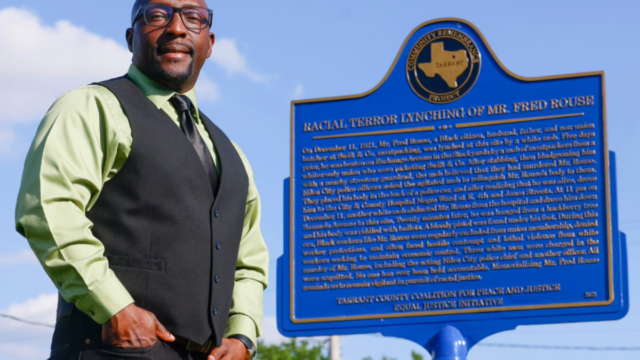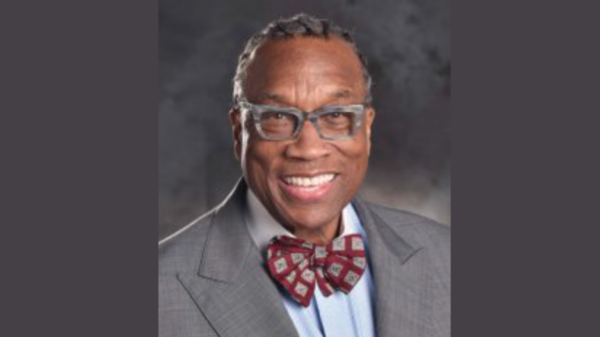
By Dave Lieber
Your name is Fred Rouse 3rd, and that number three at the end is now the defining factor of your life.
A few years back, you picked up your ringing phone and nothing would ever be the same.
“We found your grandfather,” the caller said. Must be some mistake, you replied. “I never lost him.”
No, this was the lost grandfather on your father’s side. Fred Rouse #1.
As you listened to the story of your newly discovered grandfather, the world shifted beneath your feet. Your father, Rouse Junior, never talked about his own father, neither to his children nor to his wife.
It’s understandable because, as you learned, #1 was the victim of a vicious lynching, likely by members of the Fort Worth Ku Klux Klan on Dec. 11, 1921. The story was lost for a century until local historians dug it up.
When the incident began, Rouse #1 was working at Swift & Co. meatpacking plant on East Exchange Avenue in the Fort Worth Stockyards. Company workers were on a national strike, so the company offered their jobs to Black men who became strike breakers.
In normal times, Black men like Rouse #1 couldn’t get jobs at the plant because the labor union wouldn’t accept them. Now it didn’t matter. But outside the plant the white strikers accosted Rouse and threatened him.
“You won’t be coming back to work in the morning,” one warned.
Rouse did something Blacks were taught to avoid in the presence of whites. He mouthed off.
“I’ll bet you a hundred dollars that I’ll be here at 7 a.m.,” he vowed.
Next day, he kept his promise. With a pistol in his pocket he showed up to work, and the mob of strikers attacked him. He pulled out his gun and shot two of them in self-defense. Both men would recover.
In quick response, the mob then beat him so badly, fracturing his skull, that everyone assumed he was dead.
A policeman came to take the body away, but Rouse woke up. He was taken to the City-County Hospital, the only hospital in Fort Worth that treated Blacks. While recuperating, the Ku Klux Klan came for a visit …
Stop 1: Swift & Co. building
You’re Fred Rouse 3rd, and the other day you led a tour group from the Episcopal Diocese of Texas on what’s called “The Fort Worth Lynching Tour.” The tour makes stops at the locations where #1′s story takes place. It’s a powerful way to learn history. A history of racism that is so controversial that states are passing laws prohibiting the teachings in schools.
Stop 2: The hospital
Left for dead, with eyes swollen shut, Rouse was in the only medical building in the city that would heal him. Five days after his beating his only security was a nurse — Miss Shelton, the newspapers called her.
She told how 30 men, mostly young ones, showed up to take him away. She argued, pleaded with them to let him heal. They said don’t make it any harder than it needs to be.
“He has no clothes on,” she said.
Someone said, “Where he’s going, he won’t need them.”
They grabbed the broken man from his sick bed and ran him out the door, where they removed their masks, shoved him in a car and drove him to a vacant lot, home of what locals called “the Death Tree.”
Stop 3: The Death Tree
They hung him from the hackberry tree and shot him eight times. Someone placed the pistol at his feet as his lifeless body hung above the crowd.
People drove by to gawk. The location became such a tourist attraction that the owner of the lot took the tree down in order, she explained, so everyone could have a merry Christmas.
You say, “A lot of times it’s still hard to talk about when you go into the details about how he was murdered.” You’re especially sensitive about the shots he fired at his attackers. But you know in your heart it was self-defense. Your granddad never got to give his side of the story — something most lynch victims had in common.
At first, three men were charged, but charges were dropped. Then later six men, including two former policemen, were indicted by a Tarrant County grand jury. But nothing ever came of that either.
Part of a movement
Across America, century-old lynchings are being rediscovered and their victims honored. Your grandfather has his name on a plaque with hundreds of others at The National Memorial for Peace and Justice in Montgomery, Ala. It’s known as the national lynching memorial.
When you saw it, you recalled, “I was stunned.” In Texas, more than 300 lynchings took place. Yet your name is the only one on the Tarrant County plaque. In Dallas, there were approximately 28 known lynchings, with nine of them whites and the rest Blacks.
Face history head-on
You’re Fred Rouse 3rd, and you watch how politicians in some states, including your own Texas, are doing their darndest to make sure this full history of racial violence is not shared. Some public school boards have passed policies forbidding these stories from being taught. Gov. Greg Abbott signed a state law two years ago prohibiting certain teachings about racism.
You watch as a publisher removed from elementary school lesson plans in Florida the fact that Rosa Parks was Black. Without that, her story makes no sense.
Locally, you watch as Carroll ISD, once revered, ordered a teacher at George Dawson Middle School to prohibit students from reading the chapter in Dawson’s autobiography on the lynching of Dawson’s best friend.
You watched as the first Black principal at Colleyville Heritage High School was forced out after he wrote a letter to school parents about racial issues in the aftermath of George Floyd’s murder.
“That’s what amazes me,” you say. “They don’t want kids or adults to feel guilty. But it’s OK for the African-American community to know of the pain of a loved one hung from the tree. But they don’t want to recognize what happened in the past.”
You have a wonderful way of dealing with this, your new responsibility to work with the Tarrant County Coalition for Peace and Justice to build a park on the lot where the Death Tree once stood.
The Fred Rouse Memorial is already decorated with signage. The coalition is launching a capital campaign to build a park. (Visit www.tccpj.org to learn more.)
The point, Tarrant County College history professor Bradley Borougerdi explains, is to “reclaim history and tell the story that has been denied.”
You’re doing it by picturing your grandfather uttering his final words, which you believe were: “This is only the beginning.”
In a groundbreaking ceremony on the 100th anniversary to the day of his murder, you watched how the Rouse name along with his flesh and blood — you — returned to the horrible spot.
The Fort Worth Lynching Tour, you say, “pulls the blanket back on one of the worst tragedies in Fort Worth’s history. For a century it has been hidden away.”
Stop 4: The former Ku Klux Klan building
/cloudfront-us-east-1.images.arcpublishing.com/dmn/D4RWQYHOZVBNDISE2BSWINLPTE.jpg)
The old KKK headquarters, the final stop, still stands on North Main Street. Historian Borougerdi dug up a nugget researching the building’s past. Harry Houdini was hired by the KKK to put on a show there. He titled it, “Can the Dead Speak to the Living?”
You say that when they hung your granddaddy from the tree, they thought they killed him. “They thought they killed his name.”
The KKK building is about to undergo renovation and become a community arts center highlighting the works of people of color. Its name: “The Fred Rouse Center for Arts and Community Healing.” (Visit Transform1012.org to learn more.)
As Rouse the 3rd, you have one more Houdini-like trick up your sleeve to keep the name alive.
You named your adult son Fred Rouse the Fourth. This is only the beginning.
Become a citizen of Watchdog Nation.
Join Dave Lieber and learn to be a super-consumer.
Watchdog newsletter: Sign up for The Watchdog’s FREE weekly newsletter to keep up: click here.
Subscribe: PLEASE support The Watchdog’s brand of straightforward journalism designed to save you time, money and aggravation. Treat yourself to a digital subscription (and make him look good!) by visiting https://dallasnews.com/subscribe
Watchdog Home Page: You can’t afford to miss The Watchdog’s two reports each week. Follow our latest reporting always at The Watchdog home page which features all recent columns.
Watch this free training video from Dave: https://youtu.be/uhUEUCNKGjc
Facebook: Connect with The Watchdog on our Facebook group. Search for “DallasNews Watchdog Posse.”
The Dallas Morning News Watchdog column is the 2019 winner of the top prize for column writing from the National Society of Newspaper Columnists. The contest judge called his winning entries “models of suspenseful storytelling and public service.”
Read his winning columns:
This story, originally published in The Dallas Morning News, is reprinted as part of a collaborative partnership between The Dallas Morning News and Texas Metro News. The partnership seeks to boost coverage of Dallas’ communities of color, particularly in southern Dallas- at the bottom.









